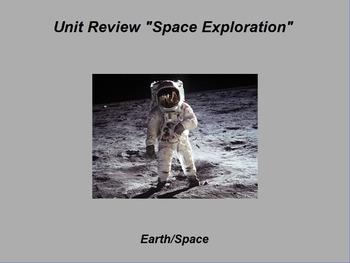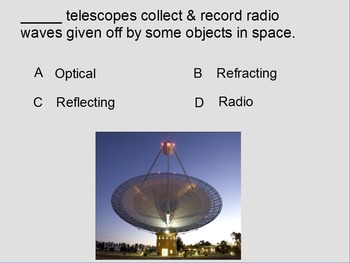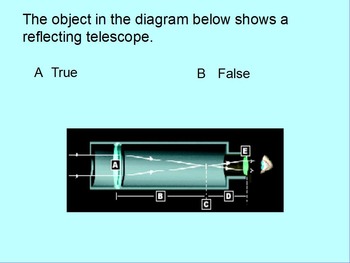Earth/Space ActivInspire Unit XI Assessment Review "Exploring Space"
- Flipchart File
Description
This unit review aligns with the Common Core State Standards (CCSS):
"STANDARDS 8 and 9 - The Universe and Practices of Science.
The competent science teacher understands and applies accepted practices and implications of science in contemporary and historical contexts.
8B. understands the properties and dynamics of objects external to the solar system.
8G. demonstrates the ability to use instruments or to explain functions of the technologies and tools used in the study of the space sciences.
9A. understands that the nature of science is a human endeavor characterized as tentative, public, replicable, probabilistic, historic, unique, holistic and empirical"
Interactive review of the unit on "Exploring Space" (Unit XI). The review contains 20 questions true/false; multiple choice and text and/or numeric responses. A PDF student worksheet/study guide can also be generated by using this program.
PowerPoint lessons contain many graphics and two links to short videos to further student understanding.
PowerPoint slides also contain notes for the instructor based on students most "frequently asked questions" or FAQ's to help clarify the subject.
A class activity is included at the end of each lesson.
* All PowerPoint lessons; ActivInspire programs; student note sheets/activities and assessments for this unit can be found under the "Earth/Space Complete Unit XI Exploring Space" zip file folder.
Terms/concepts in the unit include:
light, light year, International Space Station (ISS), stars, Earth, electromagnetic radiation, photons, wavelength, frequency, electromagnetic spectrum (EM), radio waves, microwaves, infrared light, visible light, ultraviolet, X-rays, gamma rays, telescopes, optical telescopes, refracting telescopes, reflecting telescopes, convex, concave, primary mirror, eyepiece lens, Hubble Space Telescope (HST), James Webb Space Telescope (JWST), active optics, adaptive optics, Keck twin telescopes, European Southern Observatory (ESO), radio telescopes, radio astronomy, rockets, action-reaction pairs, solid fueled rockets, liquid fueled rockets, propellant, combustion, Robert Goddard, Space Shuttle, satellites, orbit, Sputnik, space race, GPS, space probes, Mariner, Viking, Pioneer, Voyager, Galileo, Venera, Magellan, Yuri Gagarin, President Kennedy, Project Mercury, Project Gemini, Project Apollo, Apollo 11, Neil Armstrong, Edwin "Buzz" Aldrin, Michael Collins, Moon landings, space station, Skylab, Mir, Cosmonaut, weightlessness, space platform, Mars, Mercury, Messenger, Venus Express, ESA, Chang'e 1 , LRO, LRCROSS, Spirit rover, Opportunity rover, Curiosity & Perseverance rovers, Mars Odyssey, Mars Express, Cassini, Juno, Mars soil sample return mission, New Horizons, space benefits
astronomydad
Earth/Space ActivInspire Unit XI Assessment Review "Exploring Space" by astronomydad is licensed under a Creative Commons Attribution 3.0 Unported License.





